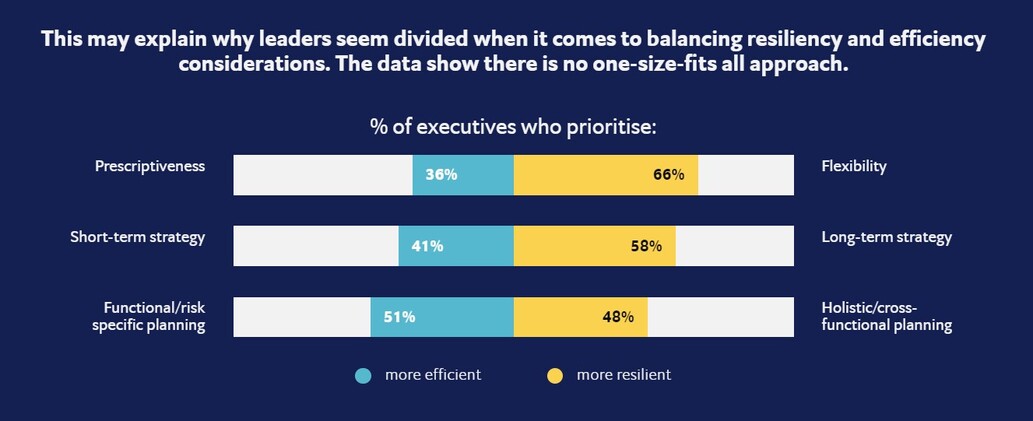How do you measure resilience? Consider what life would be like without insurance
Without a standardised metric for resilience, it can be tricky to show progress or even get executive buy-in.

Without a North Star or standardised metric for resilience, it can be tricky to show progress or even get executive buy-in. But ignoring this business imperative is akin to not having flood insurance in a hurricane zone. You can’t expect to bounce back without it.
On a sunnier note, more and more executive leaders are getting it. In fact, the 2022 Economist Impact global study, sponsored by Iron Mountain, reports that only 26% of CEOs are not involved in resilience efforts, which means the 74% in the know are rolling up their sleeves and revising their resilience playbooks, understanding that major disruptions can happen at any moment.
Readiness truly is “all”
Companies that invest in resilience and continue to stay the course will see their investment pay off over time because that strategy will enable them to respond quickly and efficiently to incidents as they occur.
“A resilient organisation is going to benefit over the long term,” says John Ferguson, Practice Lead, Globalisation, Trade and Finance at Economist Impact. “There might be periods of time when the global economy is stable and people lose their focus, but it comes back to your expectations of the future. I would prefer that the world was a bit more stable, but I do expect more global shocks.”
True. You can’t predict the future, but you can use existing KPIs or KRIs to help anticipate the potential impact that disruptions may have on your organisation. This way, cross-functional teams can see how resilience directly affects their group or line of business. You can also hold up your organisation’s traditional metrics for measuring success and performance (EBITDA, bookings, customer satisfaction, employee retention, investor activities, etc.) against how resilience may be interpreted from them.
Is your organisation as resilient as you think?
The move to Modern Resilience doesn’t need to be an uphill battle. Get started with the 2022 global study, courtesy of Economist Impact and Iron Mountain.
End the “efficiencies vs. Resilience” debate
When you embrace the notion that resilience is an enterprise-wide cultural shift and not a passing trend, you can put the polarising opinions to rest. How exactly? Start socialising the fact that it’s all part of the same cross-functional team sport. You see, post-pandemic, you tend to hear from two general camps of executives when it comes to how to go boldly forward.
Camp one is very much “Act Now!” Create whatever efficiencies necessary to fast-track new paths to profit. Basically, from a short-term operational standpoint, anything that a) somewhat aligns with shifting business priorities and b) immediately impacts the bottom line…goes.
Then there’s the more future-focused, proactive group of campers who have a bigger, typically more costly, vision around long-term resilience strategies. And they don’t want dead end stop-gaps or disruptive network Band-Aids getting in the way.
Here’s a graph that illustrates the divide:

The key takeaway: Both camps are right. How can that be? Simply put, it’s not an either/or situation. There’s nothing wrong with creating efficiencies to strengthen the supply chain and help immediate short-term revenue plays as long as it doesn’t interfere with the bigger plans that involve the long-term health and resilience of your organisation.
Dedicated time and effort: the only way forward
The 2022 Economist Impact research shows evidence of some businesses centralising this function with a chief officer or head of resilience. While at the same time, other companies are decentralising with more mid-level executive teams. Like most things, there are pros and cons either way. The trick is finding out what works best for your organisation—and sticking to it with dedicated full-time talent whose job it is to shine new light on this necessary part of doing modern business.
7 elements of a sustainable business resilience plan
INFORMATION SHARING BETWEEN DEPARTMENTS
EMPLOYEE WELL-BEING AND ENGAGEMENT
DECISION-MAKING ARCHITECTURES AND MEASUREMENT
BALACING RESILIENCE AND EFFICIENCY
ADAPTING TO NEW TECHNOLOGY
MEETING SUSTAINABILITY TARGETS
A few more sobering facts from the survey:
- 75% of leaders believe their organisation can withstand another major future disruption.
- However, only 15% involve the heads of their departments in these initiatives.
- And then only 12% of respondents say they’ve got any sort of resilience committee involved.
No matter where you stand (in operations, sales, marketing, or the C-suite), blind optimism on this topic won’t help. The effort, the strategy, and the implementation all need to be sustained. Without consistent top-down support, it’s nearly impossible to be prepared for the next global disruption—and to stay profitable in our current state of constant change.
However, if you coordinate a unified vision (with existing success metrics) across functions, teams, and time zones—and put real budget behind it—then the potential long- and short-term solutions have a much higher chance of getting implemented.
So no matter which way or how hard the hurricane winds of disruption are blowing, your organisation will be ready and resilient enough to withstand anything.
Learn more about the 4 pillars of modern resilience.
Featured services & solutions
Amplify risk management. Strengthen resilience. Empower your organisation.
Archive, backup, recover and store data with Iron Mountain portfolio of solutions. Minimise downtime and ensure business resilience and continuity.
Resilience reimagined
Are organisations ready to face the next unknown? This report, co-sponsored by The Economist and Iron Mountain, helps to answer that question.
Elevate the power of your work
Related resources
View More Resources
Elevate the power of your work with Iron Mountain

